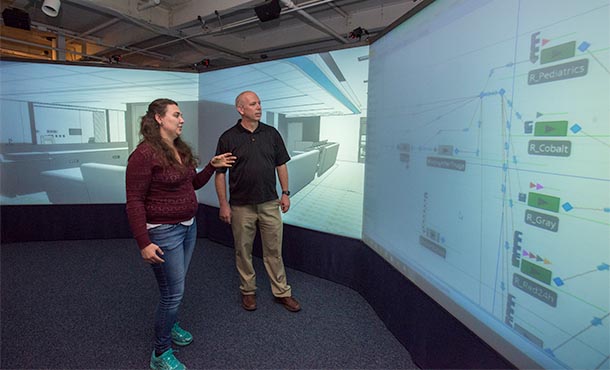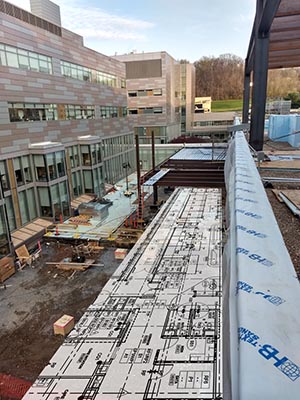
Jennifer Lather and adviser John Messner discuss the HMC Emergency Department current and future workflow embedded in the initial discrete event simulation.
The reality of simulating healthcare facilities
Graduate researcher aims to improve emergency department patient care through computational facility modeling
5/30/2018
UNIVERSITY PARK, Pa. — Healthcare is a fast-paced, ever-evolving industry. To accommodate the needs of patients and healthcare providers, the facilities they occupy must be flexible enough to address the needs of varying patient demands and situations.
Jennifer Lather, a doctoral candidate in architectural engineering, is currently using computer simulations at Penn State Hershey Medical Center to better understand how to design for the changing situations in the hospital’s emergency department (ED).
Advancements in computer simulation capabilities allow designers to create complex, immersive models of buildings before construction begins. Currently, there is little research to investigate the value of using simulations to improve design decisions. Lather’s research will work to understand healthcare industry performance metrics, such as patient wait times and length of stay, before buildings are created.
To do so, Lather is creating two simulations, which she will combine together as one cohesive simulation approach. First, she is working to create a discrete event simulation, which will simulate the processes patients go through in the emergency department. It will include random variations of arrival and healthcare service times.
A second simulation, a virtual reality visualization, will mimic a first-person perspective of the facility.
“In this type of simulation, we use digital content provided by project teams to create an immersive and interactive environment where nurses and doctors can virtually experience their future facility before it is built,” Lather said.
According to Lather, virtual reality visualizations help stakeholders better understand the facility’s design and be able to provide directed feedback to the project team. Discrete event simulations provide the data behind operational changes through temporal models of the processes in a facility.
“Through simulation, practitioners can understand if the change [to the facility] will help deliver healthcare more efficiently and effectively,” she said.
Lather is working with Eleanor Dunham, MD, medical director of the Emergency Department at Penn State Hershey Medical Center, to gather the background information on clinical operations and emergency department flow needed to create realistic simulations.
Dunham feels simulating healthcare facilities is extremely important due to its cost-effective nature and the opportunity it provides to change building design, when needed, in order to lead to better functionality and patient care.
“Hopefully this research will help to make current operations in the emergency department more efficient in terms of staffing and patient satisfaction,” she said.
Lather will test how the data from the discrete event simulation can supplement the virtual reality environment. She will test different integration techniques that include having specific information available as healthcare representatives walk through the virtual facility, including waiting room times, overview statistics when in a bird’s-eye view, and nurse utilization statistics when visiting different treatment area.
Five different areas of the ED will be simulated with different layouts to test how changes will impact important performance metrics. Of those, the top three near optimal layouts will be selected. Healthcare practitioners will be presented with these options and asked to choose which layout they prefer. To better understand how they come to their decisions, Lather is gathering data on time taken to make the decision, model understanding, confidence in decision and the process of decision making.
“Advances in computing technology have enabled us to see future facilities before they are built. If we can find better ways to integrate that information into the complex design process, we can create buildings that respond to humans and not the other way around,” Lather said.
Dunham agreed, she believes better healthcare facility design can impact both the patients and the healthcare providers in many different ways.
“Better design organization not only helps with the tangible, measurable goals such as savings [or] decreased cost, decreased length of stay in the ED, [and] increased efficiencies, but it also promotes better health and well-being not only of the patient being cared for, but [also] for the staff who are caring for the patient.”
Lather believes that by engaging a subset of end users, the healthcare practitioners, in the design process, the design of healthcare facilities will be better connected with the operational uses of the facilities.
“Using these simulations, we can assess the impacts from a quantitative and qualitative way and help project teams understand the needs of the users in new ways,” she said. “If we can better understand and assess the processes used to deliver care, we hopefully can react better and assimilate new knowledge of best practices easier into the healthcare delivery process.”




